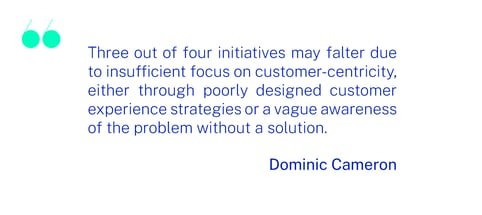4 tips for perfecting your omnichannel strategy
Customers have never had so much choice. The amount of goods and services they can buy, the number of retailers they can buy from, and the range of buying methods they can choose from, is rising all the time. While this is great news for consumers, it does mean that there is constant pressure on retailers and brands to proactively connect with customers and deliver the experiences they’re looking for.
The solution: omnichannel strategy
Embracing an omnichannel approach is the answer. This strategy combines multiple touchpoints, functions, and digital platforms to meet and exceed customer expectations, offering a significant competitive advantage.
However, perfecting an omnichannel experience can be easier said than done. It requires detailed data to be gathered, unified and analyzed, and experiences to be shaped based on insights from that data. It requires use of the latest technology, including artificial intelligence and automation, to build accurate customer profiles and enable refined personalization. And it requires a culture of continuous improvement to match the omnichannel strategy to changing consumer desires and behaviors over time.
We interviewed Dominic Cameron, ex-CTO of lastminute.com, to understand the biggest barriers to developing a customer-centric omnichannel strategy, how these problems can be solved, and why AI in particular has an increasingly important role to play.
The barriers to omnichannel success
Marketing teams, and indeed retailers as a whole, have understood the need for customer centricity for a long time. However, the fact that different departments have often worked in isolation with each other means that the ability to embrace a true omnichannel approach has often been held back. Typical barriers include:
Siloed capabilities:
Different departments building solutions based on an assumption of customer needs, rather than any data-driven insights. This can often lead to solutions that don’t serve any pressing customer need, or that do so initially but are rendered obsolete shortly afterwards as consumer demands change.
Lack of coordination:
When departments are working separately, they regularly end up developing different apps and products, or even develop very similar solutions that overlap. This can easily lead to confusion and inconsistency for the customer, and hamper their ability to get a smooth buying experience.
Misalignment with business objectives:
If there is no joined-up thinking between departments, especially with regards to overall business objectives and strategy, it becomes much more difficult to prioritize and integrate the customer journey.
Underinvestment:
If there aren’t enough people dedicated to interpreting, tracking and understanding customer needs, then there isn’t the internal pressure to secure the investment that a customer-centric approach requires.
 All of the challenges listed above contribute to a fragmented, disjointed approach that can impair the ability of a business to deliver on customer expectations. The impacts can include:
All of the challenges listed above contribute to a fragmented, disjointed approach that can impair the ability of a business to deliver on customer expectations. The impacts can include:
Disparate data:
A disconnect between different data sets and sources means accurate insights on customers can’t be found, and decision-making isn’t as fact-driven as it could be.
Siloed channels:
Limited or no connectivity between channels means that customer interactions are disjointed, reducing the impact of marketing campaigns.
Lack of a full customer view:
The inability to establish a detailed, accurate view of existing and/or prospective customers limits the impact of any targeting, personalization or relationship nurturing.
.png?width=870&height=387&name=infographic_2%20(1).png)
Lack of integration:
When teams and systems aren’t working together, processes can’t run seamlessly and efficiently, which can cause knock-on impacts throughout the customer journey.
Inconsistent messaging:
When messaging isn’t coherent or consistent from the start of a customer journey to the end, customers will feel less confidence and trust about shopping with a brand due to confusion.
These impacts can all contribute to suboptimal customer experiences, lower levels of loyalty, and unnecessary difficulty in generating growth, revenue and profitability. That’s why a more coordinated, all-encompassing approach is the only practical way forward for success.
The power of data and AI in unison
The biggest players in the consumer and retail industries, such as Amazon, have raised the bar in customer experience and personalization terms. They have combined data and artificial intelligence in such a way as to craft individual experiences that resonate with the unique desires and needs of each customer. That way, they can deliver seamless, frictionless experiences where consumers barely notice that they’re being precisely targeted, if indeed they notice at all.
Businesses that are fully enabled with tech, data and AI are able to transcend traditional barriers in customer experience, right from the very first interaction in the customer journey. This also means they can innovate, engage and excel in ways that their competitors can’t:
Recommendation engines:
AI can analyze previous interactions and customer preferences to suggest recommendations personalized to each customer. This can drive better engagement, greater conversions, and help build stronger brand/customer relationships.
Customer behavior prediction:
Machine learning models and predictive analytics can help brands anticipate the most likely ‘next moves’ that a customer will take. This could be a particular product they’re interested in or a service they might need, but either way, it allows brands to stay one step ahead of the customer and make the buying journey appear more intuitive along the way.
Bespoke content creation:
AI-powered content creation makes it viable to deliver personalized messages, adverts and web pages to large numbers of individual customers and users. This level of personalization makes them feel more valued, and helps build customer loyalty.
Personalized customer service:
Connected to the previous point, AI can also support individual service through support mechanisms such as chatbots. Combined with more traditional email and phone-based support, this allows for omnichannel customer service that is consistent and tailored across every point of contact.
Omnichannel journeys:
The development of omnichannel journeys means customers can move seamlessly from online to offline channels and vice versa; for example, finding clothing items online and reserving them in their nearest store to view and try on. Other touchpoints can be integrated here to encourage movement through the buying journey, such as real-time push notifications.
Dynamic pricing and messaging:
AI algorithms can enable real-time variation in the pricing and messaging that each individual customer sees, based on demand, buying history and customer loyalty. This allows personalized buying journeys to be refined in real time, so as to maximize the chances of a successful conversion, and of a positive experience for the customer.
How does this AI-led strategy work in practice?
All of the above sounds great for any brand, and the good news is that this level of innovation isn’t the sole preserve of industry giants like Amazon. It’s well within the reach of brands of all shapes and sizes, but it does require some thorough preparation work and AI enablement behind the scenes. Ideally, this should include:
Customer journey mapping:
Gaining an understanding of the full customer journey from end-to-end is vital, so that consistency, personalization and AI can be built in at the right points along the way.
Data strategy and architecture refining:
Every good AI-led omnichannel experience is built on a robust, adaptable and scalable data architecture. Combined with a focused data strategy, it’s then possible to capture the right customer information, unify it from various sources, and gain the insights needed to deliver personalization across every channel.
Customer behavior analysis:
AI-driven analytics should be used to build accurate, detailed models of customer behavior, ensuring that all captured data is actionable and supporting the right approach to personalization.
AI for automation:
AI also has a vital part to play in automating many of the processes that can be repetitive and time-consuming, making personalization faster, easier and more practical to implement. It can also be used to analyze huge data sets in real time, so that brands can adapt and respond to changes, whether at individual customer level or within the marketplace as a whole.
Personalization tool selection:
Having the right platforms in place to deliver personalized omnichannel experiences is essential. A stack including the likes of CRM systems and AI-powered analytics tools enables brands to deliver on expectations for greater personalization.
Having all this in place means data is more coordinated, integration is stronger, customer insights are more accurate and detailed, and more engaging and satisfying customer experiences can be delivered every time. This will ultimately generate happier customers, better conversion rates, smoother platform development, greater cost efficiencies and a healthier bottom line. By harnessing the power of data and AI in unison, businesses can not only meet but exceed customer expectations, and position themselves as leaders in the modern market landscape.
By harnessing the power of data and AI in unison, businesses can not only meet but exceed customer expectations, and position themselves as leaders in the modern market landscape.
Where to start with your omnichannel strategy
As this guide demonstrates, perfecting an omnichannel strategy needs many different processes and technologies to come together, so it can be difficult to know what to do first. At Ciklum, we’ve helped countless brands just like yours go through this omnichannel development journey, and we’ve established the four key foundations that will set you up for success:
At Ciklum, we’ve helped countless brands just like yours go through this omnichannel development journey, and we’ve established the four key foundations that will set you up for success:
Assess your data infrastructure:
Evaluate your existing data infrastructure in-depth, and identify any gaps or bottlenecks in your data ingestion and analysis processes. This is critical for understanding your data capabilities, and making informed decisions about technological changes you may need to make.
Develop a customer journey map:
A comprehensive customer journey plan will outline all touchpoints, any potential pain points, and present opportunities for AI and personalization to be used. This map should form the basis from which you can craft targeted, seamless experiences across all channels.
Unify customer data with real-time profiling:
Use the right platforms to consolidate vast amounts of customer data from disparate sources into comprehensive, real–time customer profiles. This can give you the insights needed to deliver personalized experiences that will resonate and prompt the actions you want.
Collaborate with expert partners:
Working with an expert third party can help you achieve your technical goals, including the deployment of AI and automation technologies. Their experience will also prove instrumental in helping you use these innovations to their full potential.
 These steps will give you more confidence in your business decisions, and will allow you to scale and allocate resources more effectively. Furthermore, as you invest in your omnichannel strategy, you'll see improved returns on investment and heightened customer satisfaction, positioning your business for sustained success in a dynamic and highly competitive marketplace.
These steps will give you more confidence in your business decisions, and will allow you to scale and allocate resources more effectively. Furthermore, as you invest in your omnichannel strategy, you'll see improved returns on investment and heightened customer satisfaction, positioning your business for sustained success in a dynamic and highly competitive marketplace.
If you feel like you need help on the way to perfecting your omnichannel strategy, then Ciklum can support you with advice, planning, technology implementation and ongoing support. Get in touch with our team today to discuss your specifics, and we’ll make sure you’re on the right track.
You may also like
Subscribe to receive our exclusive newsletter with the latest news and trends
Subscribe to receive our exclusive newsletter with the latest news and trends
Want to reach out directly to us?
hello@ciklum.com
© Ciklum 2002-2023. All rights reserved


